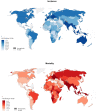Disease burden, risk factors, and trends of lip, oral cavity, pharyngeal cancers: A global analysis
- PMID: 37519070
- PMCID: PMC10524054
- DOI: 10.1002/cam4.6391
Disease burden, risk factors, and trends of lip, oral cavity, pharyngeal cancers: A global analysis
Abstract
Background: Lip, oral and pharyngeal cancers make up a small percentage of total cancer cases worldwide and have reported lower rates of cancer-related deaths globally in 2020, but their 5-year survival rate in either early or advanced stages is different. The study evaluated the global incidence, mortality, risk factors, and temporal trends by age, gender, and geographical locations of lip, oral cavity, and pharyngeal cancer.
Methods: Incidence and mortality rates were extracted from Cancer Incidence in Five Continents (CI5) volumes I-XI, the Nordic Cancer Registries (NORDCAN), the Surveillance, Epidemiology, and End Results (SEER) Program, and the WHO IARC mortality database. Joinpoint regression was used to calculate the Average Annual Percentage Change to examine trends.
Results: The highest incidence rates were found in Melanesia and South-Central Asia and mortality rates were 8.2 and 7.5. Risk factors associated with incidence and mortality included HDI, tobacco use, alcohol consumption, poor diet, and chronic health conditions such as hypertension. Increasing trends of incidence and mortality were observed in females from Malta; males aged 50 and above from the United Kingdom, and females aged 50 and above from Slovakia reporting the largest increase.
Conclusions: Although global incidence and mortality trends reported an overall decrease, significant increases were found for older age groups and female subjects. Incidence increase may be due to the growing prevalence of lifestyle, metabolic risk factors, and HPV infections, especially in developed countries.
Keywords: burden; lip; oral cavity; pharyngeal cancer; risk factors; temporal trends.
© 2023 The Authors. Cancer Medicine published by John Wiley & Sons Ltd.
Figures





References
-
- Sung H, Ferlay J, Siegel RL, et al. Global cancer statistics 2020: GLOBOCAN estimates of incidence and mortality worldwide for 36 cancers in 185 countries. CA Cancer J Clin. 2021;71(3):209‐249. - PubMed
-
- Warnakulasuriya S. Global epidemiology of oral and oropharyngeal cancer. Oral Oncol. 2009;45(4):309‐316. - PubMed
-
- Bell RB, Kademani D, Homer L, Dierks EJ, Potter BE. Tongue cancer: is there a difference in survival compared with other subsites in the Oral cavity? J Oral Maxillofac Surg. 2007;65(2):229‐236. - PubMed
-
- Hashibe M, Brennan P, Benhamou S, et al. Alcohol drinking in never users of tobacco, cigarette smoking in never drinkers, and the risk of head and neck cancer: pooled analysis in the International Head and Neck Cancer Epidemiology Consortium. J Natl Cancer Inst. 2007;99(10):777‐789. - PubMed
MeSH terms
LinkOut - more resources
Full Text Sources
Medical

